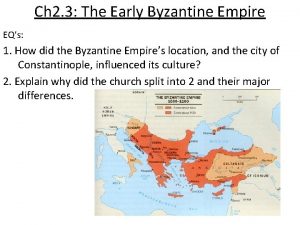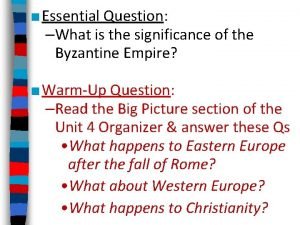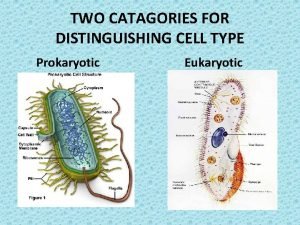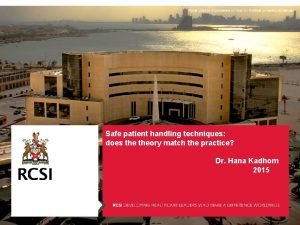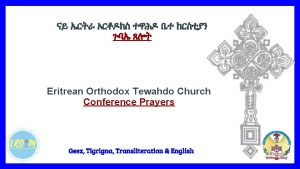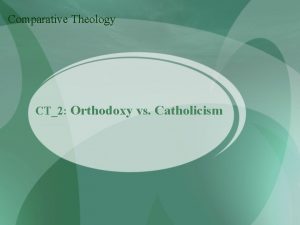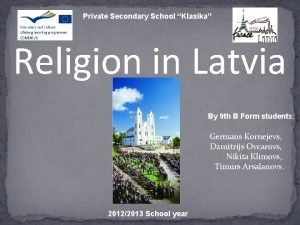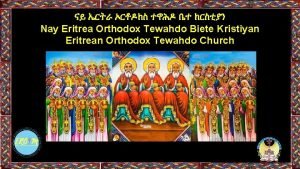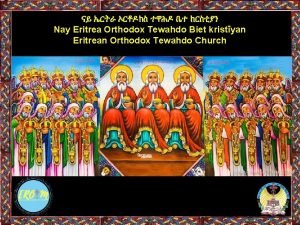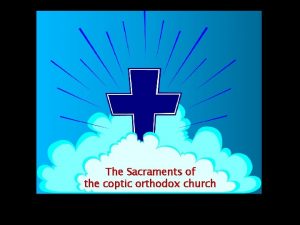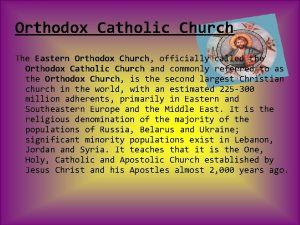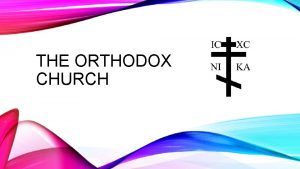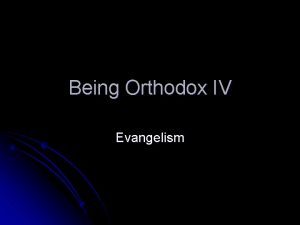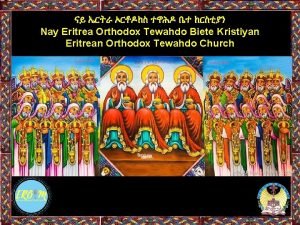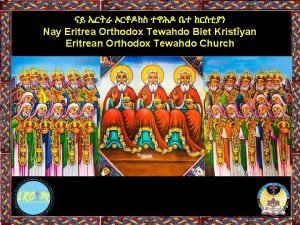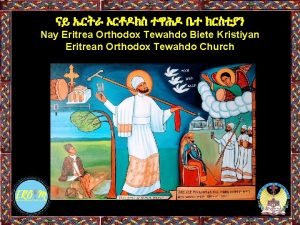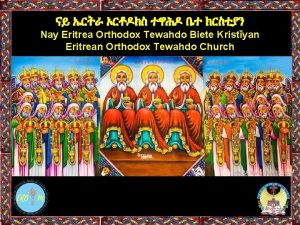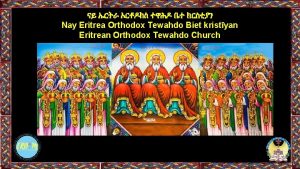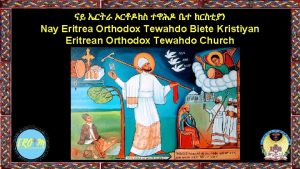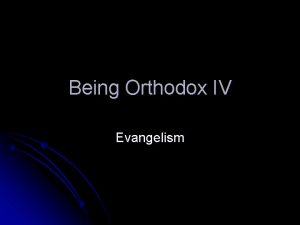Eastern Orthodox and Eastern Catholic Two Distinguishing Groups













- Slides: 13

Eastern Orthodox and Eastern Catholic

§ Two Distinguishing Groups § Churches in Full Communion with Rome (Eastern Catholic Church) § Churches in Outside full Communion (Eastern Orthodox Church) § Early Church the first 300 years: § The early Church was unified around the Apostles and their immediate successors. § Grappled with controlling heresies; the Magisterium was accepted as the means to settle disputes over doctrine, theology and governance § Unity was evidenced by: evangelization, the sacraments, and persecution

§ East and West Roman Empire § Diocletian divided the Roman Empire § Rome / Constantinople § Constantine § Sees a vision of a cross in the clouds with a sign prior to going to battle § “In this sign you will conquer. ” § Edict of Milan (313 CE follows) § Arianism - Jesus (and Holy Spirit) was created by the Father prior to the Incarnation; at issue WAS Jesus’ being “eternally begotten by the Father”? § Council of Nicaea – response consubstantial or of the same being § Nicene Creed (325 AD) promulgated

The Nicene Creed We believe in one God, the Father, the Almighty, Maker of all that is, seen and unseen. We believe in one Lord, Jesus Christ, the only Son of God, eternally begotten of the Father, God from God, Light from Light, true God from true God, begotten, not made, consubstantial of one Being with the Father. Through him all things were made. For us and for our salvation he came down from heaven: and by the Holy Spirit was incarnate he became incarnate from the Virgin Mary, and was made man. For our sake he was crucified under Pontius Pilate; he suffered death and was buried. On the third day he rose again in accordance with the Scriptures; he ascended into heaven and is seated at the right hand of the Father. He will come again in glory to judge the living and the dead, and his kingdom will have no end. We believe in the Holy Spirit, the Lord, the giver of life, who proceeds from the Father and the Son. With the Father and the Son he is worshipped and glorified. He has spoken through the Prophets. We believe in one holy catholic and apostolic Church. We acknowledge one baptism for the forgiveness of sins. We look for the resurrection of the dead, and the life of the world to come. Amen.

§ Constantine Governance Decision § Rome is capital of West Roman Empire § Byzantium named capital of East § Constantine changes name to Constantinople the “New Rome” § Theodosius (379 AD) § Declares (Rome) Christianity the official religion of the state § Attempts to denounce and squash Arianism coming from the East § Calls for an Ecumenical Council to unify Church (Constantinople 381 AD) § Holy Trinity and four marks of Church proclaimed § (one, holy, catholic, apostolic)

§ Barbarians battled the Western Empire, finally overthrew Rome in 476 AD § East spoke Greek / West spoke Latin § Making communication more difficult § The Eastern Roman (Byzantine) Empire remained strong § Weak political leadership in the West caused people to look to the Church for discipline and order in society § Language as well as cultural and differences expanded the gulf between East and West

§ Bishop Nestorian 428– 431 (Nestorianism ) § Protested title given Mary of Theotokos (God-bearer or Mother of God) § He believed Mary was only the mother of the man Jesus, not Jesus in his divinity; thus separating his human and divine natures § Rationale: a mother gives birth to a person, not his nature § Claimed Jesus has two loosely divided natures, human and divine § Loyal followers fled the R. E. and moved to Persia (Iraq and Iran) § Monophysite (Monophysiteism) § Claimed Jesus had only one nature – divine; his human nature was absorbed into his divine (like salt in water) § Council of Chalcedon refuted this teaching, clarifying with the concept of a hypostatic union (two natures in one) § Loyal Monophysites were primarily in Alexandria (Egypt)

§ The East and West Theologians § West – St. Augustine § the West focused on the unity of the Trinity § East – St. John St. Chrysostom, St. Basil, St. Gregory of Nyssa § East focused on the diversity of the persons of the Trinity § Devotional and liturgical practiced diverged over time § Church Structure § Primacy of Peter’s successor generally accepted § Metropolitans (Archbishops) developed as a means to collaborate § Patriarchs were major cities looked to as the leaders of the Church (Rome, Alexandria, Antioch, and then Jerusalem and Constantinople) § Only Rome was in the West; the others all in the East § The East operated with Rome having “primacy among equals”

§ Filioque controversy (“…and the Son”) § Was commonly added to the Nicene Creed to strengthen (anti-Arian) belief in the divinity of Jesus § “I believe in the Holy Spirit, the Lord and Giver of Life, who proceeds from the Father and the Son. ” § In the East, the Filioque line was not added § Filioque eventually was endorsed by the Pope (Rome), which caused the East to react because such a change should happen via an Ecumenical Council § This remains a significant division between East and West § The Catechism states a difference of semantics (CCC 248)

§ Pope Leo III “crowns” Charlemagne as emperor § The Pope is seen as THE leader of the West § As a Catholic, Charlemagne used military force to defend the empire and the Church, as well as to “convert” pagans § Thus the name the Holy Roman Empire, because it is led by the Pope § The East was largely autonomous from the rule of the Pope § 1054 marks the date for the split of East and West § West had always used unleavened bread for the Eucharist; the East used leavened bread § A delegate of the Pope (Cardinal Humbert) was sent to resolve the issue § When the Patriarch of Constantinople refused to assimilate, a mutual excommunication happened § Henceforth, each Church viewed the other as a separate entity

§ Crusades blunder § The East appealed to the West for help in battling the Muslim armies (who had taken control of Jerusalem) § East and West had found a common rival, thus the Crusades § 4 th Crusade (1202 - 1204) § Against an order of the Pope, Western armies invaded Constantinople and ransacked the city, killing people and desecrating the Churches § Councils called to seek reconciliation § Lyon (1274) East bishops agree, but negated upon return home § Florence (1431) again union was agreed to, but negated when no military assistance arrived to fight Muslim invaders § Constantinople falls to the Muslims § JPII (2001) formally apologized and asked forgiveness for the ransacking of Constantinople in 1204

§ Apostolic Succession – both Churches have bishops who are direct successors to the apostles § Sacraments – priests are valid, therefore sacraments are valid; there are differences in language and practice: § Mass is referred to as the Divine Liturgy § Baptism by immersion, along with Eucharist and Confirmation (leavened bread used for the Eucharist) § Papal Primacy – East rejects Papal infallibility and Popes’ universal jurisdiction § East accepts infallibility of the Church, not the Pope § East accepts Bishop of Rome as an honorary leader, with no authority outside being a spokesperson for the College of Bishops

§ Mary – East does not acknowledge the Immaculate Conception, though they do honor Mary devotionally. The East accept the dogma of the Assumption (called the Dormition or “falling asleep), that Mary died, then three days later her body was taken to heaven. § Priestly Celibacy – celibacy became a West requirement in 1139, 2 nd Lateran Council; the East has continued to ordain married priests; bishops are celibate § Marriage and Divorce – East accepts divorce as a means of compassion for human weakness (up to two remarriages); accept some forms of artificial birth control § Spirituality – we share much the same spirituality and saints, though the East has a different liturgical calendar § Liturgy is formal with an emphasis on the divine mystery of God. Formal vestments, incense, formal gestures, processions, adoration of Eucharist and icons
 Roman catholic vs eastern orthodox
Roman catholic vs eastern orthodox Differences between catholic and orthodox
Differences between catholic and orthodox What are two distinguishing characteristics of prokaryotes
What are two distinguishing characteristics of prokaryotes How are ethnic groups and religious groups related
How are ethnic groups and religious groups related Orthodox lifting in nursing
Orthodox lifting in nursing Tigrinya prayer
Tigrinya prayer Orthodox doctrine
Orthodox doctrine Thubden orthodox
Thubden orthodox Religion in latvia
Religion in latvia ገብር ሔር
ገብር ሔር Selam leki tselot
Selam leki tselot Christian bale orthodox
Christian bale orthodox The orthodox lift
The orthodox lift 7 sacraments orthodox church
7 sacraments orthodox church
